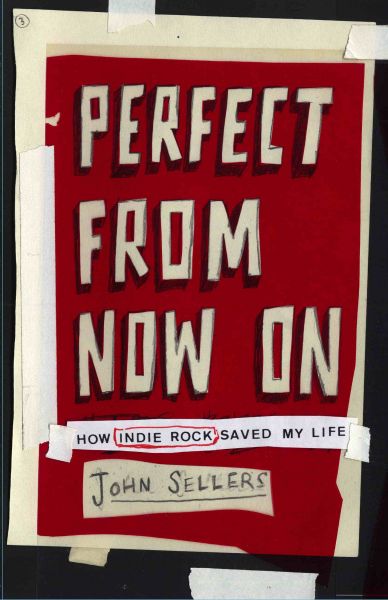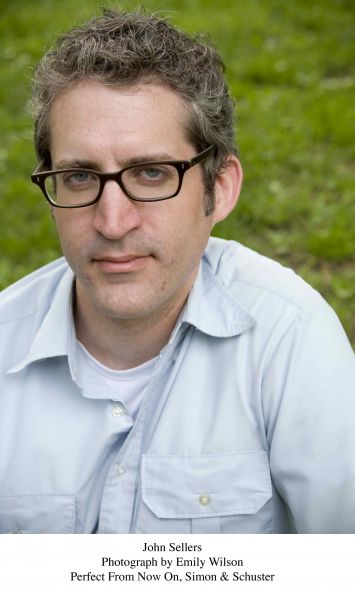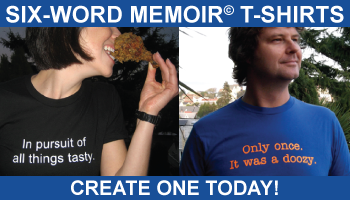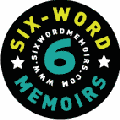Perfect From Now On by John Sellers
Friday, June 1st, 2007
Songs John Sellers recommends you listen to while reading this excerpt (in order):
1. Joy Division, “Disorder”
2. The Smiths, “The Headmaster Ritual”
3. The Pixies, “Gouge Away”
4. Pavement, “Fillmore Jive”
5. Guided By Voices, “I Am a Scientist”
Listen to an audio interview with John Sellers.
+++

Quick quiz:
1) Read the following passage and answer A or B:
“One of the most comforting places for a teenager who knows he has zero chance to make meaningful contact with the girl of his dreams is alone at the wheel of a car, with his favorite music turned up loud.”
a) Dude, how did you know?
b) My dad never let me drive the car.
2) A radio show in which each week the DJ plays the same song, say, Guided By Voices “I Am a Scientist,” over and over for an hour, interspersed with insightful anecdotes as to “why it ruled” is:
a) Awesome.
b) A slow, painful death.
3) The following chain of obsessions/events:
Live New Order show > Joy Division > Manchester, England > The Smiths > Morrissey > Oscar Wilde > English major > music writer/memoirist
a) Makes perfect sense.
b) What’s Joy Division?
If you answered A to all of the above, then you will delight in and devour Perfect From Now On, John Sellers’s story of his 35+ years on the planet as seen through the lens of indie rock.1 The music is the thread that takes Sellers from Grand Rapids, Michigan (where his father tortured him with his worship of Bob Dylan), to New York City (where he tortured his girlfriend with Guided By Voices), but Perfect is also about the power of a passion to make a person do silly, sad, and occasionally beautiful things. And more often than not, witness that passion take all our money along the way.
 Angsty, entertaining, self-deprecating, obsessively foot-noted, highly appendicized, and featuring no less then three puking scenes that made me laugh out loud (I’m not proud of it, but still), Perfect is a terrific riff for indie rock fans, and, really, anyone who liked High Fidelity even a little. Load up your iPod and let the soundtrack to John Sellers’s life carry you away. —Larry Smith
Angsty, entertaining, self-deprecating, obsessively foot-noted, highly appendicized, and featuring no less then three puking scenes that made me laugh out loud (I’m not proud of it, but still), Perfect is a terrific riff for indie rock fans, and, really, anyone who liked High Fidelity even a little. Load up your iPod and let the soundtrack to John Sellers’s life carry you away. —Larry Smith
1) If you didn’t answer A, then as much as I personally read this book in three sittings, to my own delight found the at-first-insufferable footnotes ultimately excellent, and am buying the book for many friends, the B people might not find a whole lot for them here. Then again, even if you don’t toil in the temple of indie rock, keep an open mind.
+++
The following excerpt is taken from Chapter 1: My Impression Now
A PARTIAL LIST OF THINGS MUSIC has made me do: fly overseas at considerable expense to see a live performance by a band I no longer liked, nurture a crush on a goth chick way out of my league, nurture a crush on an alternachick way out of my league, write a love letter to a German woman made up entirely of lyrics from my favorite synth band, get ticketed for doing 82 in a 55, drive around a remote area of England looking for a hero’s grave, wear parachute pants without irony, switch college majors, shoplift, dive to the bottom of a numbingly cold Scottish pond to retrieve a favorite T-shirt, stab my thumb into the back of a fellow concert attendee’s neck to get closer to the stage, drink too much, lose my voice, stage-dive, cry, and regret. But it wasn’t until I was thirty-three—on a Friday night in April 2004, to be more specific—that I found out exactly how important music was to me.
The evening began like so many others: the twist of a bottle cap, the first sip of beer, the descent of my buttocks into the swivel chair at my desk. My computer, a bulky eMac, still excited me a full year after I purchased it, in large part because it had completely changed the way I listened to music. Converting all of my CDs into searchable digital files had spoiled me. Gone were the days of hauling my carcass up to the wall-mounted CD rack to find the one disc that contained the one song required at a given moment. That song was now available with a click of the mouse—and it could be found while sitting down. Once again I fired up the iTunes program and within seconds a familiar song was dominating my apartment. As I scrolled through more than three thousand songs for the perfect follow-up, the value of iTunes as something other than a tool to organize and burn CDs revealed itself in a bang: play count. How had I failed to scrutinize this ingenious function before? Here in front of me was an unadulterated reckoning of how often I’d listened to each song in my collection since the uploading had begun nearly twelve months before—amazing. The frequency of seemingly uncountable thoughts and actions, such as the number of times I’ve said sthe word “awesome” or the sheer poundage of pizza I’ve eaten, has tantalized me for years, a desire that grew, most likely, out of a Saturday Night Live sketch from the late 1980s about a guy who arrives in heaven and proceeds to quiz an angel about all sorts of arcane trivia about his life, such as “What’s the two hundredth grossest thing I ever ate?” (The answer: butterscotch pudding with a dead earwig in it.) Play count was offering up information that I wasn’t supposed to have until death.
Not surprisingly, the numbers, in aggregate, confirmed that indie rock is my favorite genre of music; it has been for nearly two decades now. That term could use some clarification—in part because the phrase has become nebulous in this relatively recent era in which Borglike conglomerates have swallowed up labels once considered too insignificant to matter, and also because indie rock may be defined differently depending on whom you ask. Back in the early 1980s, when the term started getting thrown around, things were relatively simple: You were either on an independent label or you weren’t—and if you weren’t, then you probably sucked, at least to die-hard fans of the genre. But then R.E.M. got popular. And Nirvana. So now confusion reigns. Purists might disagree, but I think the term can now safely apply to anything that feels independent, whether published on an obscure label or something insidiously corporate, and it can include songs that many people associate more closely with another of indie music’s many aliases and subgenres: hardcore, postpunk, grunge, shoegazing, lo-fi, emo, and stuff we older sorts used to refer to as college rock or modern rock. Such classifications, as you might expect, can be personal. Most indie aficionados—that moderately large listener base that has always been woefully underserved by mainstream radio and MTV—would probably consider Sonic Youth and Hüsker Dü and Dinosaur Jr. and Built to Spill and even Death Cab for Cutie to have retained their credibility after signing with majors. But what about the Smashing Pumpkins? How best to judge the case of Radiohead, which has always been on a major label? And what of Weezer, another major-label lifer—and one, in fact, that seems to be an independent band created in a major-label-funded laboratory experiment? I’ll settle it: They’re all indie.
However the genre is defined, I’m a fan. Well, mostly. Actually, lots of indie rock sucks worse than Dan Fogelberg. And just because I love indie music doesn’t mean that it’s all I listen to or that it’s the only genre that matters. There is value in the Toto song “Hold the Line.” I own every original studio album by Led Zeppelin, not to mention Coda. I will always possess the gene that makes some guys turn their vehicle into Neil Peart’s ninety-nine-piece drum kit whenever Rush’s “Tom Sawyer” comes on. But I’ll get into all that later. What’s at issue here is that, thanks to the play count discovery, my listening habits were now both quantifiable and sortable. It was thrilling even to look at tracks that didn’t rank among my favorites. How many times had I played the Pixies’ “Velouria” in the past year? Twelve times—a manageable once-a-month craving. Songs by old favorites New Order and the Cure were played in the same moderation as those by newer go-tos the Shins and the New Pornographers. Van Halen’s “Everybody Wants Some!!” (22 listens) ranked ahead of anything by Nirvana, but the average number of times I’d listened to the first eleven songs on Nevermind (5.9 times)1 greatly exceeded that of the eight songs on Women and Children First (3.8 listens). But obviously this is not the information that blew my mind.
No, what made me reconsider my place in life were the songs at the top of the list when sorted by play count. At 193 listens, the song I had played most often during the previous twelve months was written by a band that most people have never heard of. In fact, the top ten songs—and seventeen of the top twenty (and thirty-five of the top fifty, and sixty-three of the top one hundred)—were all by that same band or its offshoots. The facts told me what I had only just begun admitting to myself: I was obsessed with Guided By Voices.
++++
NOW THERE ARE A FEW WAYS you can give in to musical obsession. You can give in suddenly and briefly—such as when, over the course of a few weeks or months, you find yourself hooked on a particular album (especially a debut album or a breakout album) and start talking up the artist to everyone you know; but then, after seeing a boring live performance or hearing someone you don’t respect gush about the music, you just as suddenly denounce the artist as being annoying or unoriginal.
Or you can give in sporadically. This might happen if you are dealing with unfamiliar real-world concerns, such as a new job or mouth to feed, when you have neither the time nor the energy to satisfy the rigors of a full-blown obsession; it might also be that your passion peaked years ago and is only at the edges of your synapses now. But the mania is merely in remission; it is still there, waiting to flare up, much like herpes, at certain and often unpredictable moments: a release of a new bootleg, an anniversary of a hero’s death, a reunion tour, a simpatico comment by a bartender, a delivery of killer weed.
Or of course you can go all in—and indeed, this is the most recognizable form of musical obsession. You let it dip into every facet of your life: your wardrobe, your hairstyle, the foods you eat, the drugs you take, the naming of your pets and children. Fanship of this type is generally expressed outwardly and unabashedly, and as such it tends to draw the bewilderment and ridicule of those who don’t understand. Not that you really care what those morons think. You may appear on an MTV program talking about your fanatical devotion; you will almost certainly blog about it. Tattoos are possibly involved, and in wacko cases, plastic surgery. If you observe a hero wearing a hearing aid or wielding gladioli, you will likely get an intense urge to be seen in public wearing a hearing aid or wielding gladioli. There is a sense of competition among your own kind to be known as the most dedicated fan. But you also feel most comfortable when among other faithfuls, and you may even have friends or a spouse whom you met at a show or through a message board. En masse, you and your brethren may be given a label by outsiders, usually derogatorily: Deadheads, Phishheads, Parrotheads, metalheads, goths, Elvis freaks, Teshies, Idiots Who Think That Michael Jackson Isn’t a Child Molester. In other words, you are the Trekkies of musical fandom. But you are also that most loyal of fans: willing, in theory, to get beaten down defending the music you love.
—— 1) The album’s finale, “Something in the Way,” can’t be counted reliably because it features a hidden track: Specifically, there is the familiar 3-minute, 48-second song of woe, then 10:03 of silence, and then 6:41 of dial-a-grunge. I’m usually long gone by the time it kicks back in.
From Perfect From Now On by John Sellers. Copyright 2007 by John Sellers. Reprinted by permission of Simon & Schuster, Inc.
Buy Perfect From Now On on Amazon.






Oh man, I have to buy this book. My son is great friends with Kevin March and I know he’ll want to take Perfect From Now On on tour with him this summer…after I read it first, that is.
Ha ha - and oh boy can I relate. I know what my insane love of music has made me do…
xo
Rob
In my opinion, advices from https://eduessayhelper.org/blog/critical-lens-essay might be really useful for college students. It will help you with writing your critical lens essay
I really like some of these songs. That’s why I like this post so much. I will share it https://justdomyhomework.com/blog/concert-report here.
Wow! Thank you! I always needed to write on my site something like that. Can I take a fragment of your post to my blog?
With Spotify Premium you can have a lot of songs and also a lot of great music available in the world link.
Well Said & Good to Know You.
i really like your content about music & spotify is my best application for podcasting…Download & install Spotify Premium MOD APK
With Spotify Mod APK, I unlock a world of unlimited music, bypassing restrictions and enjoying premium features without limits. It’s like having a VIP pass to the ultimate musical adventure, where every track is at my fingertips, enhancing every moment with its rhythm and melody.
Hotstar Premium APK offers a unique and convenient way to access a vast array of entertainment content right at your fingertips. With this modified version of the Hotstar app, users can enjoy streaming movies, TV shows, live sports, and more, all without the constraints of subscriptions or premium features.
When diving into “Perfect From Now On” by John Sellers, the musical journey suggested by the author can elevate your reading experience to a whole new level. Start with Joy Division’s haunting “Disorder” to set the mood, then groove along with The Smiths’ “The Headmaster Ritual.” As you delve deeper, let The Pixies’ “Gouge Away” and Pavement’s “Fillmore Jive” enrich the narrative, finally pondering the lyrics of Guided By Voices’ “I Am a Scientist” in reflection. For a deeper dive into the author’s insights, the audio interview with John Sellers is a must-listen. And when it comes to translating this immersive experience into the digital realm, consider crafting a literary world within Minecraft , where each block and structure reflects the essence of the written word, creating an interactive space where creativity and storytelling intertwine.
I found a very few people at this planet which match my music taste. You are one of them dude. Especially about spotify premium apk.